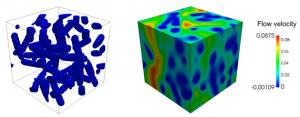Direct numerical simulations of fluid-solid interactions with non-spherical particles
This project is part of a larger ERC project in which quantitative understanding of the hydrodynamics of gas-fluidised systems of non-spherical granular particles will be achieved through a combination of modelling and experimentation, with an emphasis on modelling. The models range from detailed models of particle and fluid interactions to more coarse-grained models, which use correlations obtained from the fundamental models, for large-scale applications. The models are validated experimentally, using state-of-the-art non-invasive techniques such as particle image velocimetry, digital image analysis, and magnetic particle tracking.
In this subproject, wefocus on direct numerical simulations (DNS) of such non-spherical particles at different Reynolds numbers, different solids volume fractions, different particle orientations and different amount of mutual orientation (orientational order). The simulations are performed using the lattice Boltzmann method (LBM). The objective is to develop closures for drag, lift and torque for the non-spherical particle assemblies (as in the figure). These closures can be used in larger Euler-Lagrangian scale fluidization simulations, which would be subsequently compared with experiments. The LBM code is highly parallelized and is executed at SURFsara Amsterdam, the Dutch national supercomputing facility, currently up to several hundred processors per simulation.
Figure.Random configurations of sphero-cylindrical particles (left). Corresponding velocity contours for flow around such particles (right).
